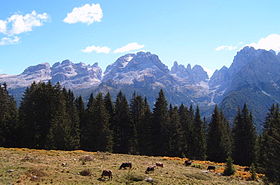Brenta Group
| Brenta Group | |
|---|---|
| Italian: Dolomiti di Brenta | |

Brenta Group mountain range.
|
|
| Highest point | |
| Peak | Cima Tosa (disputed) |
| Elevation | 3,173 m (10,410 ft) |
| Coordinates | 46°9′26″N 10°52′16″E / 46.15722°N 10.87111°ECoordinates: 46°9′26″N 10°52′16″E / 46.15722°N 10.87111°E |
| Geography | |
| Location | Trentino, Italy |
| Parent range | Rhaetian Alps |
The Brenta Group or Brenta Dolomites (Italian: Dolomiti di Brenta) is a mountain range, and a subrange of the Rhaetian Alps in the Southern Limestone Alps mountain group. They are located in the Province of Trentino, in northeastern Italy. It is the only dolomitic group west of river Adige. Therefore, geographically, they have not always been considered a part of the Dolomites mountain ranges. Geologically, however, they definitely are - and therefore sometimes called the "Western Dolomites". As part of the Dolomites, the Brenta Group has been officially recognized as UNESCO World Heritage Site under the World Heritage Convention.
Geologically, the Brenta Group is very different from the granite-formed neighboring mountain groups like Ortles and Adamello/Presanella. The main peaks are formed of hard compact dolomite, while the peripheral subgroups often are made up of more calcareous dolomite or limestone. The hard dolomite (dolomia principale) was originally formed during the Mesozoic era, under the surface of the shallow Tethys Ocean, some 200 million years ago. The hard compact dolomite with a high magnesium content was formed during the Upper Triassic period. The softer, more calcareous material was deposited later, in the late Triassic and early Jurassic period. The difference is clearly noticeable for the climber who gets a much more compact and reliable rock on the peaks of the central part of the Brenta Group than in the peripheral subgroups. Eventually, these layers were pushed upwards by the tectonic activity that led to the formation of the Alps during the Eocene, starting some 66 million years ago and leading to the formation of folds and thrust faults. Subsequent erosion carved out the dolomitic landscape with its steep vertical pinnacles, as we know it now. Although the remnants of hugh moraines suggests that the Brenta group was once encapsulated by big glaciers, the remnants of those are now very modest and have been steadily shrinking over the course of the last hundred years. Traditionally, the Brenta glaciers were relatively small and called "vedrette". Over the last hundred years their size has been reduced to often smaller than half of their original size around 1900. Climate change appears to be the main reason.
...
Wikipedia

